Implementation of Machine Learning in E-commerce: A Case Study of JD Company
VerifiedAdded on 2022/10/15
|16
|3722
|493
AI Summary
This report discusses the implementation of machine learning in an online retail company, JD Company, in Australia. It covers the advantages and disadvantages of machine learning in the industry, ethical, legal, and social issues, and recommendations for improvement.
Contribute Materials
Your contribution can guide someone’s learning journey. Share your
documents today.
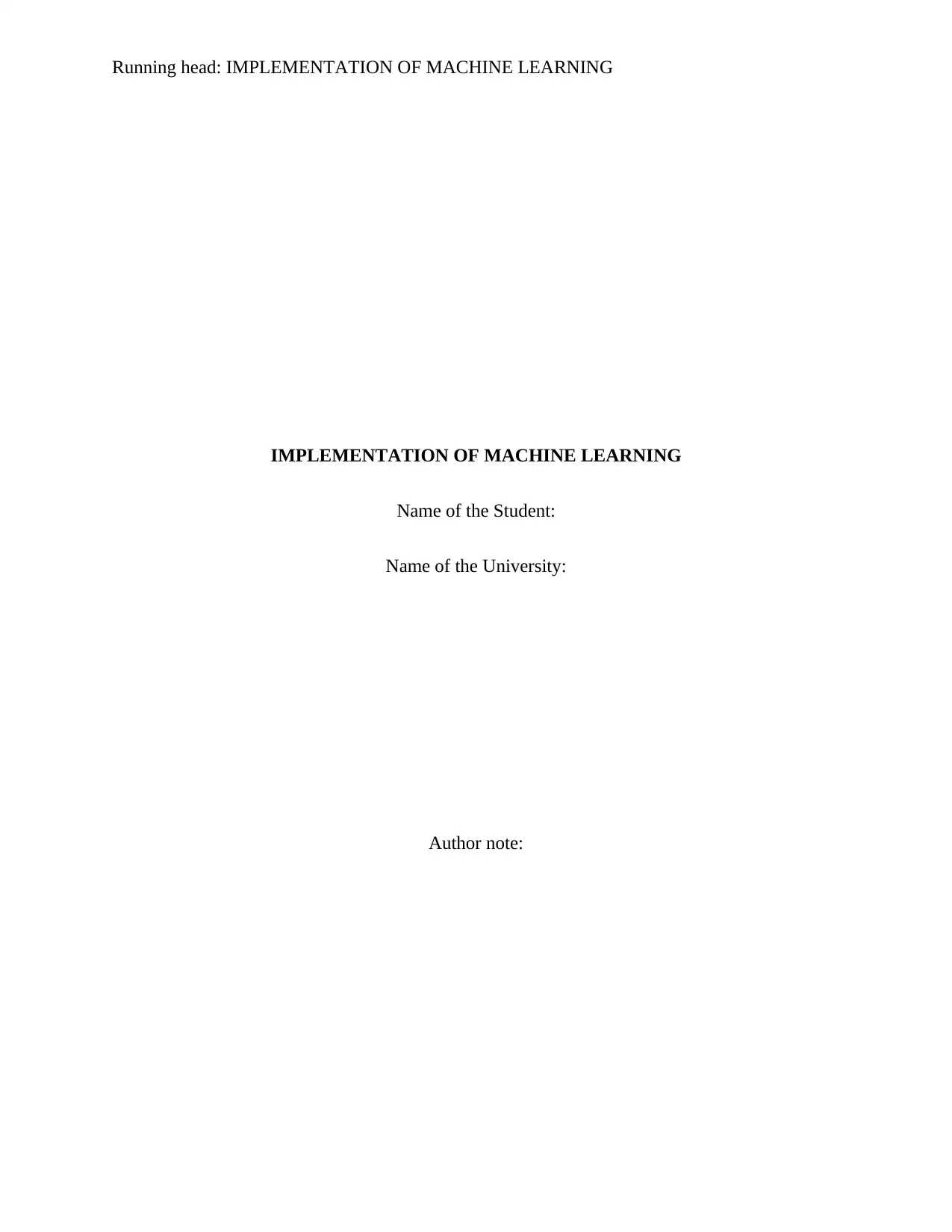
Running head: IMPLEMENTATION OF MACHINE LEARNING
IMPLEMENTATION OF MACHINE LEARNING
Name of the Student:
Name of the University:
Author note:
IMPLEMENTATION OF MACHINE LEARNING
Name of the Student:
Name of the University:
Author note:
Secure Best Marks with AI Grader
Need help grading? Try our AI Grader for instant feedback on your assignments.
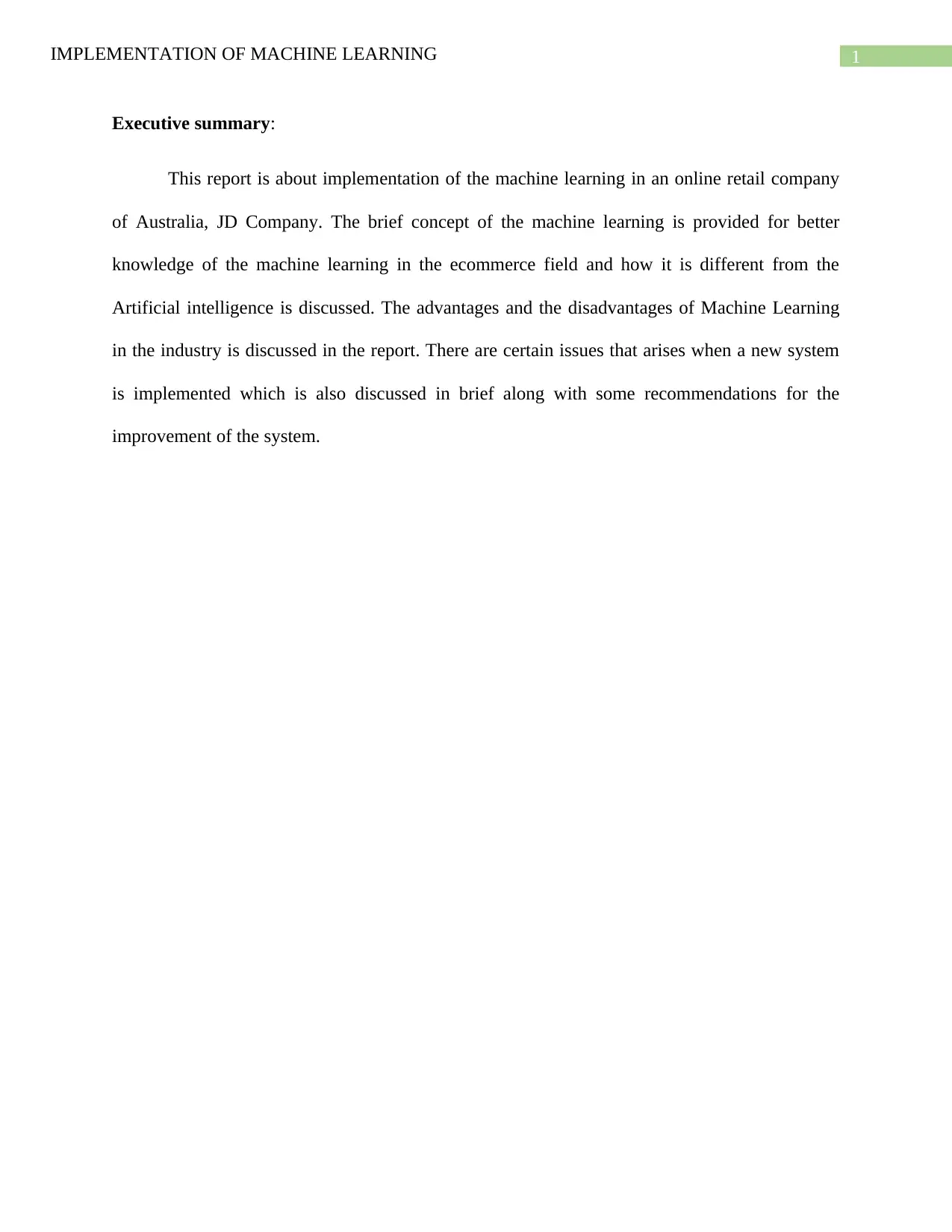
1IMPLEMENTATION OF MACHINE LEARNING
Executive summary:
This report is about implementation of the machine learning in an online retail company
of Australia, JD Company. The brief concept of the machine learning is provided for better
knowledge of the machine learning in the ecommerce field and how it is different from the
Artificial intelligence is discussed. The advantages and the disadvantages of Machine Learning
in the industry is discussed in the report. There are certain issues that arises when a new system
is implemented which is also discussed in brief along with some recommendations for the
improvement of the system.
Executive summary:
This report is about implementation of the machine learning in an online retail company
of Australia, JD Company. The brief concept of the machine learning is provided for better
knowledge of the machine learning in the ecommerce field and how it is different from the
Artificial intelligence is discussed. The advantages and the disadvantages of Machine Learning
in the industry is discussed in the report. There are certain issues that arises when a new system
is implemented which is also discussed in brief along with some recommendations for the
improvement of the system.
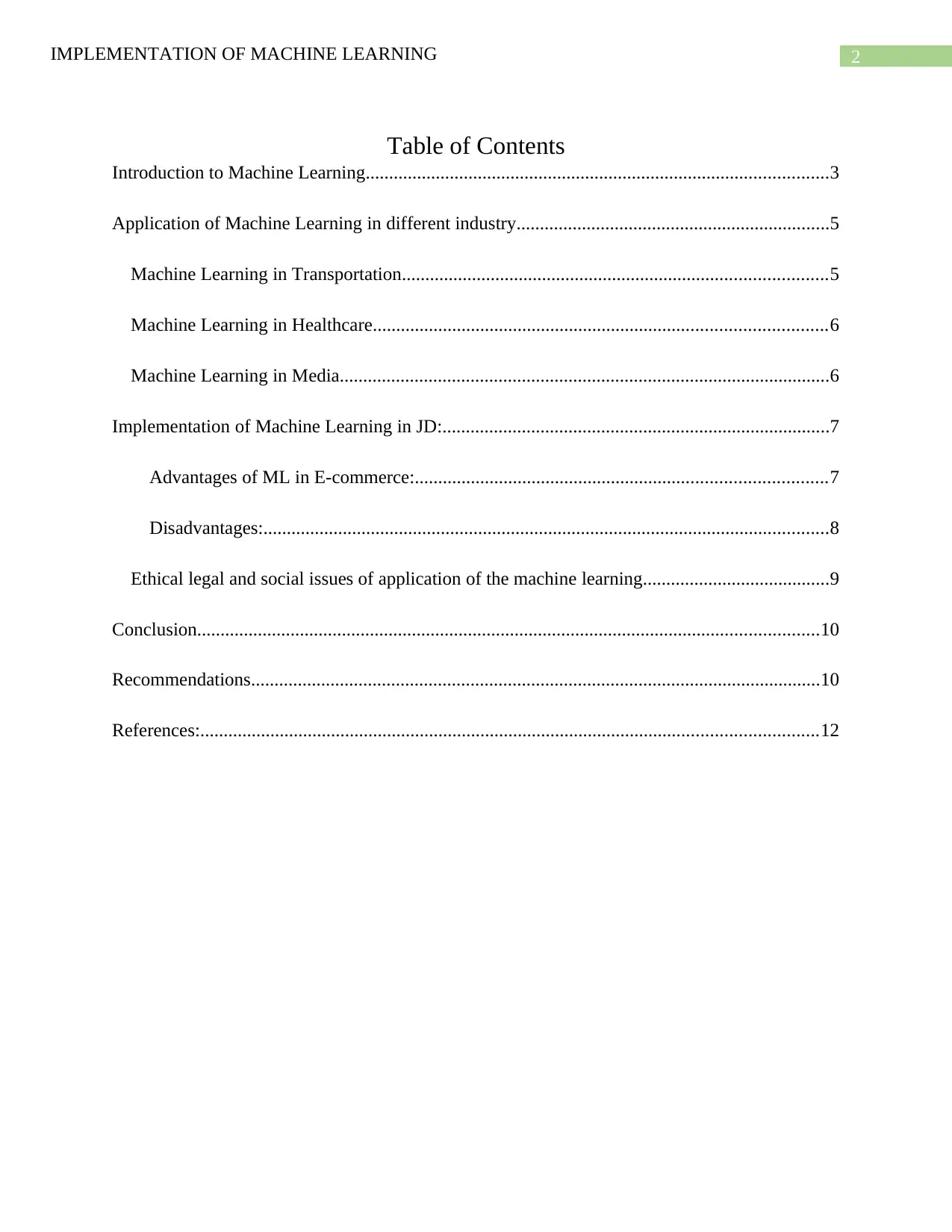
2IMPLEMENTATION OF MACHINE LEARNING
Table of Contents
Introduction to Machine Learning...................................................................................................3
Application of Machine Learning in different industry...................................................................5
Machine Learning in Transportation...........................................................................................5
Machine Learning in Healthcare.................................................................................................6
Machine Learning in Media.........................................................................................................6
Implementation of Machine Learning in JD:...................................................................................7
Advantages of ML in E-commerce:........................................................................................7
Disadvantages:.........................................................................................................................8
Ethical legal and social issues of application of the machine learning........................................9
Conclusion.....................................................................................................................................10
Recommendations..........................................................................................................................10
References:....................................................................................................................................12
Table of Contents
Introduction to Machine Learning...................................................................................................3
Application of Machine Learning in different industry...................................................................5
Machine Learning in Transportation...........................................................................................5
Machine Learning in Healthcare.................................................................................................6
Machine Learning in Media.........................................................................................................6
Implementation of Machine Learning in JD:...................................................................................7
Advantages of ML in E-commerce:........................................................................................7
Disadvantages:.........................................................................................................................8
Ethical legal and social issues of application of the machine learning........................................9
Conclusion.....................................................................................................................................10
Recommendations..........................................................................................................................10
References:....................................................................................................................................12
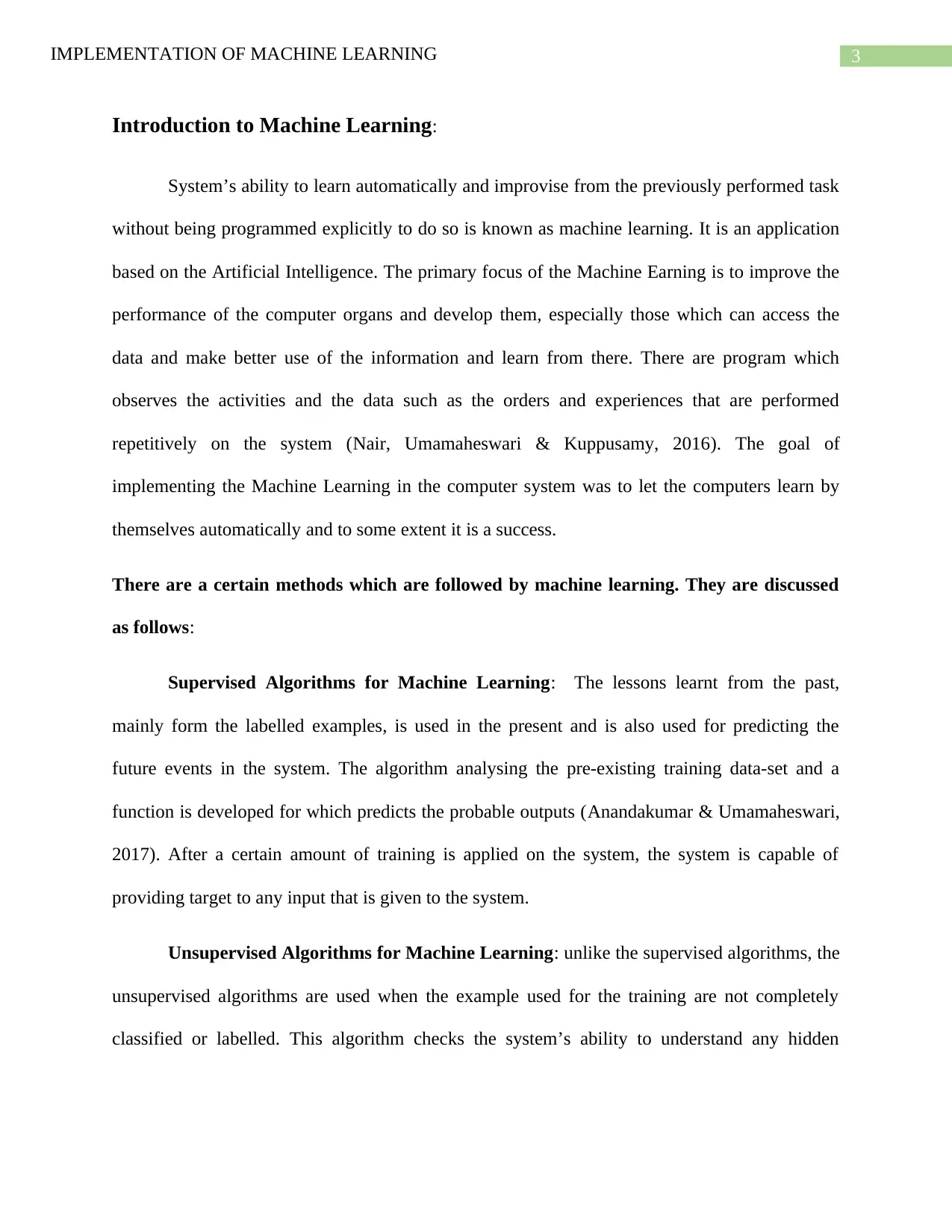
3IMPLEMENTATION OF MACHINE LEARNING
Introduction to Machine Learning:
System’s ability to learn automatically and improvise from the previously performed task
without being programmed explicitly to do so is known as machine learning. It is an application
based on the Artificial Intelligence. The primary focus of the Machine Earning is to improve the
performance of the computer organs and develop them, especially those which can access the
data and make better use of the information and learn from there. There are program which
observes the activities and the data such as the orders and experiences that are performed
repetitively on the system (Nair, Umamaheswari & Kuppusamy, 2016). The goal of
implementing the Machine Learning in the computer system was to let the computers learn by
themselves automatically and to some extent it is a success.
There are a certain methods which are followed by machine learning. They are discussed
as follows:
Supervised Algorithms for Machine Learning: The lessons learnt from the past,
mainly form the labelled examples, is used in the present and is also used for predicting the
future events in the system. The algorithm analysing the pre-existing training data-set and a
function is developed for which predicts the probable outputs (Anandakumar & Umamaheswari,
2017). After a certain amount of training is applied on the system, the system is capable of
providing target to any input that is given to the system.
Unsupervised Algorithms for Machine Learning: unlike the supervised algorithms, the
unsupervised algorithms are used when the example used for the training are not completely
classified or labelled. This algorithm checks the system’s ability to understand any hidden
Introduction to Machine Learning:
System’s ability to learn automatically and improvise from the previously performed task
without being programmed explicitly to do so is known as machine learning. It is an application
based on the Artificial Intelligence. The primary focus of the Machine Earning is to improve the
performance of the computer organs and develop them, especially those which can access the
data and make better use of the information and learn from there. There are program which
observes the activities and the data such as the orders and experiences that are performed
repetitively on the system (Nair, Umamaheswari & Kuppusamy, 2016). The goal of
implementing the Machine Learning in the computer system was to let the computers learn by
themselves automatically and to some extent it is a success.
There are a certain methods which are followed by machine learning. They are discussed
as follows:
Supervised Algorithms for Machine Learning: The lessons learnt from the past,
mainly form the labelled examples, is used in the present and is also used for predicting the
future events in the system. The algorithm analysing the pre-existing training data-set and a
function is developed for which predicts the probable outputs (Anandakumar & Umamaheswari,
2017). After a certain amount of training is applied on the system, the system is capable of
providing target to any input that is given to the system.
Unsupervised Algorithms for Machine Learning: unlike the supervised algorithms, the
unsupervised algorithms are used when the example used for the training are not completely
classified or labelled. This algorithm checks the system’s ability to understand any hidden
Secure Best Marks with AI Grader
Need help grading? Try our AI Grader for instant feedback on your assignments.
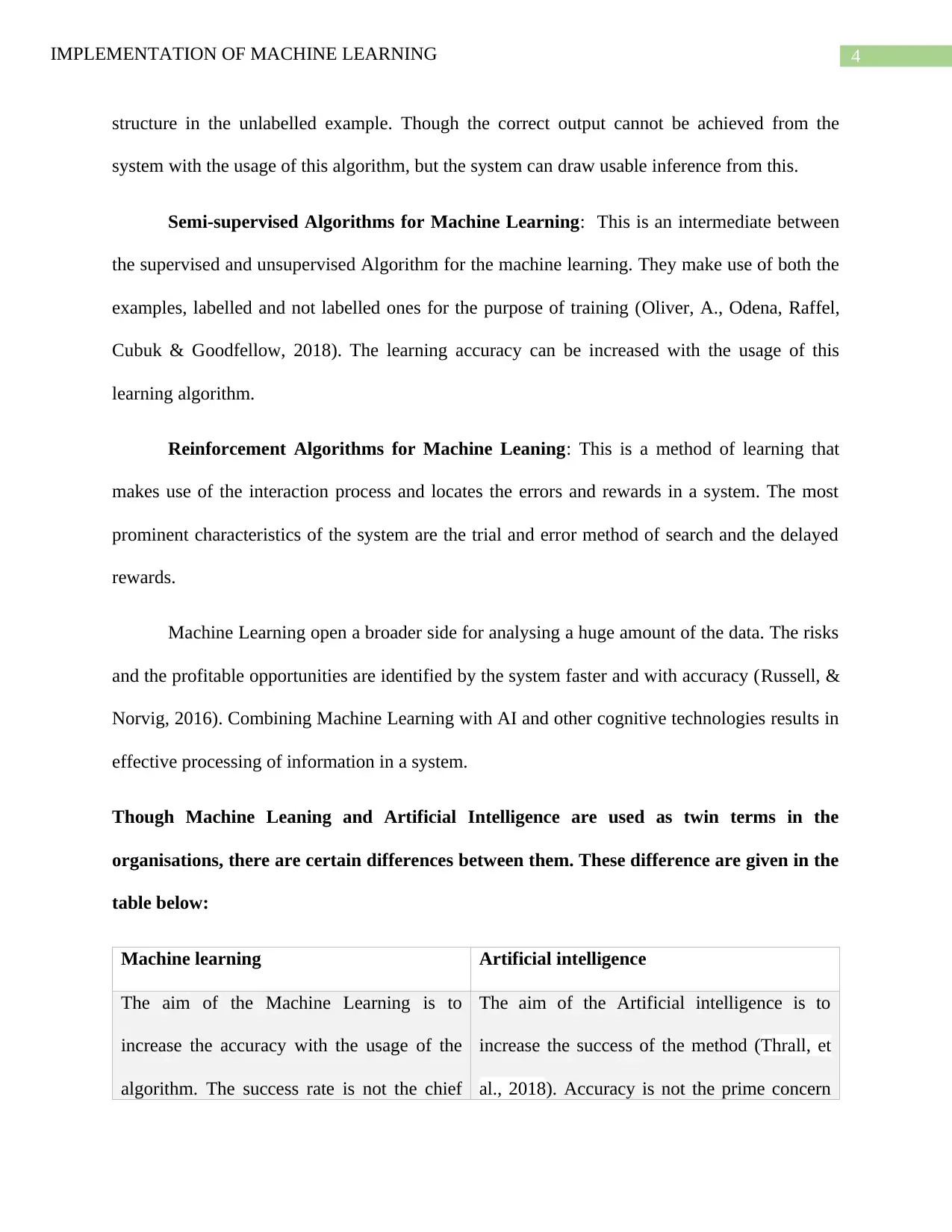
4IMPLEMENTATION OF MACHINE LEARNING
structure in the unlabelled example. Though the correct output cannot be achieved from the
system with the usage of this algorithm, but the system can draw usable inference from this.
Semi-supervised Algorithms for Machine Learning: This is an intermediate between
the supervised and unsupervised Algorithm for the machine learning. They make use of both the
examples, labelled and not labelled ones for the purpose of training (Oliver, A., Odena, Raffel,
Cubuk & Goodfellow, 2018). The learning accuracy can be increased with the usage of this
learning algorithm.
Reinforcement Algorithms for Machine Leaning: This is a method of learning that
makes use of the interaction process and locates the errors and rewards in a system. The most
prominent characteristics of the system are the trial and error method of search and the delayed
rewards.
Machine Learning open a broader side for analysing a huge amount of the data. The risks
and the profitable opportunities are identified by the system faster and with accuracy (Russell, &
Norvig, 2016). Combining Machine Learning with AI and other cognitive technologies results in
effective processing of information in a system.
Though Machine Leaning and Artificial Intelligence are used as twin terms in the
organisations, there are certain differences between them. These difference are given in the
table below:
Machine learning Artificial intelligence
The aim of the Machine Learning is to
increase the accuracy with the usage of the
algorithm. The success rate is not the chief
The aim of the Artificial intelligence is to
increase the success of the method (Thrall, et
al., 2018). Accuracy is not the prime concern
structure in the unlabelled example. Though the correct output cannot be achieved from the
system with the usage of this algorithm, but the system can draw usable inference from this.
Semi-supervised Algorithms for Machine Learning: This is an intermediate between
the supervised and unsupervised Algorithm for the machine learning. They make use of both the
examples, labelled and not labelled ones for the purpose of training (Oliver, A., Odena, Raffel,
Cubuk & Goodfellow, 2018). The learning accuracy can be increased with the usage of this
learning algorithm.
Reinforcement Algorithms for Machine Leaning: This is a method of learning that
makes use of the interaction process and locates the errors and rewards in a system. The most
prominent characteristics of the system are the trial and error method of search and the delayed
rewards.
Machine Learning open a broader side for analysing a huge amount of the data. The risks
and the profitable opportunities are identified by the system faster and with accuracy (Russell, &
Norvig, 2016). Combining Machine Learning with AI and other cognitive technologies results in
effective processing of information in a system.
Though Machine Leaning and Artificial Intelligence are used as twin terms in the
organisations, there are certain differences between them. These difference are given in the
table below:
Machine learning Artificial intelligence
The aim of the Machine Learning is to
increase the accuracy with the usage of the
algorithm. The success rate is not the chief
The aim of the Artificial intelligence is to
increase the success of the method (Thrall, et
al., 2018). Accuracy is not the prime concern
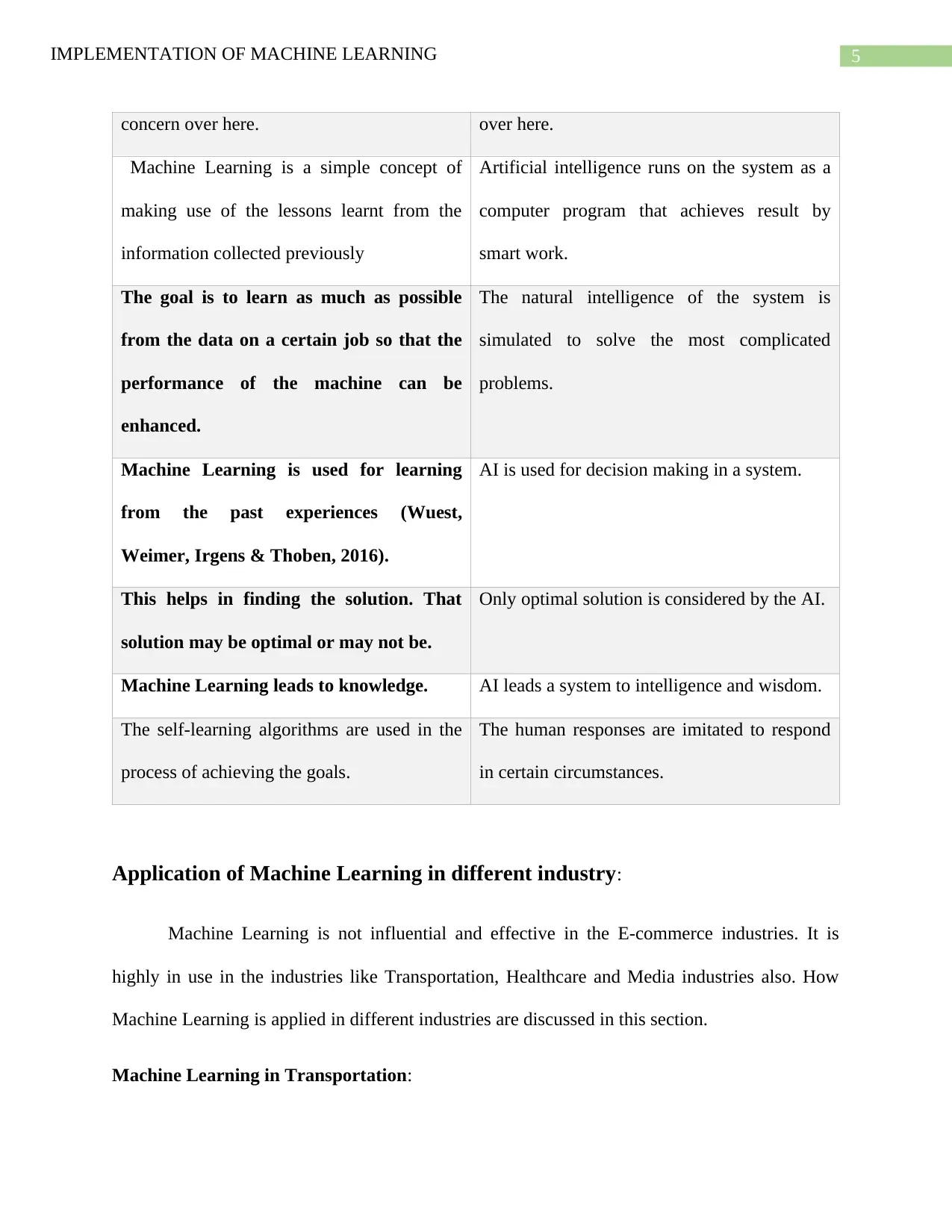
5IMPLEMENTATION OF MACHINE LEARNING
concern over here. over here.
Machine Learning is a simple concept of
making use of the lessons learnt from the
information collected previously
Artificial intelligence runs on the system as a
computer program that achieves result by
smart work.
The goal is to learn as much as possible
from the data on a certain job so that the
performance of the machine can be
enhanced.
The natural intelligence of the system is
simulated to solve the most complicated
problems.
Machine Learning is used for learning
from the past experiences (Wuest,
Weimer, Irgens & Thoben, 2016).
AI is used for decision making in a system.
This helps in finding the solution. That
solution may be optimal or may not be.
Only optimal solution is considered by the AI.
Machine Learning leads to knowledge. AI leads a system to intelligence and wisdom.
The self-learning algorithms are used in the
process of achieving the goals.
The human responses are imitated to respond
in certain circumstances.
Application of Machine Learning in different industry:
Machine Learning is not influential and effective in the E-commerce industries. It is
highly in use in the industries like Transportation, Healthcare and Media industries also. How
Machine Learning is applied in different industries are discussed in this section.
Machine Learning in Transportation:
concern over here. over here.
Machine Learning is a simple concept of
making use of the lessons learnt from the
information collected previously
Artificial intelligence runs on the system as a
computer program that achieves result by
smart work.
The goal is to learn as much as possible
from the data on a certain job so that the
performance of the machine can be
enhanced.
The natural intelligence of the system is
simulated to solve the most complicated
problems.
Machine Learning is used for learning
from the past experiences (Wuest,
Weimer, Irgens & Thoben, 2016).
AI is used for decision making in a system.
This helps in finding the solution. That
solution may be optimal or may not be.
Only optimal solution is considered by the AI.
Machine Learning leads to knowledge. AI leads a system to intelligence and wisdom.
The self-learning algorithms are used in the
process of achieving the goals.
The human responses are imitated to respond
in certain circumstances.
Application of Machine Learning in different industry:
Machine Learning is not influential and effective in the E-commerce industries. It is
highly in use in the industries like Transportation, Healthcare and Media industries also. How
Machine Learning is applied in different industries are discussed in this section.
Machine Learning in Transportation:
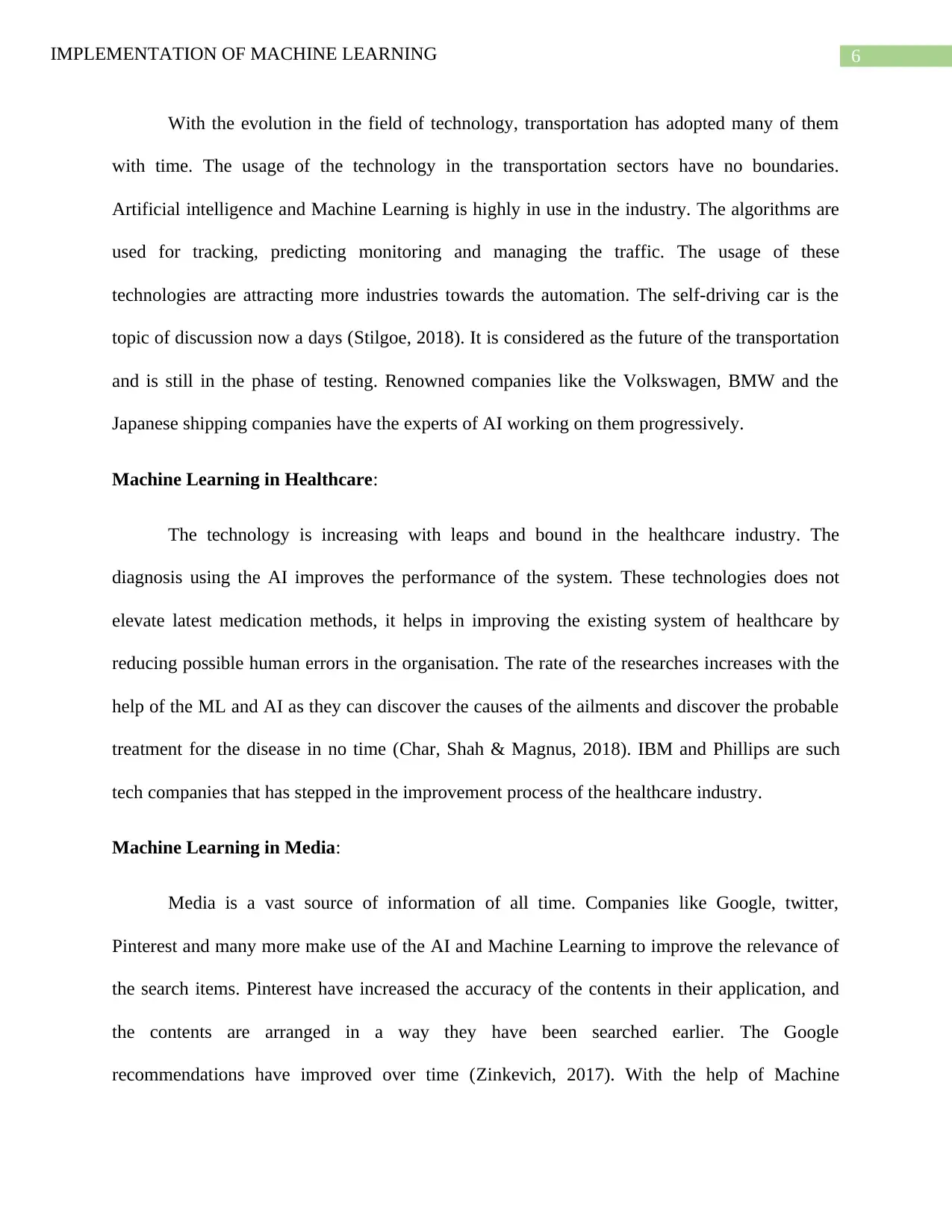
6IMPLEMENTATION OF MACHINE LEARNING
With the evolution in the field of technology, transportation has adopted many of them
with time. The usage of the technology in the transportation sectors have no boundaries.
Artificial intelligence and Machine Learning is highly in use in the industry. The algorithms are
used for tracking, predicting monitoring and managing the traffic. The usage of these
technologies are attracting more industries towards the automation. The self-driving car is the
topic of discussion now a days (Stilgoe, 2018). It is considered as the future of the transportation
and is still in the phase of testing. Renowned companies like the Volkswagen, BMW and the
Japanese shipping companies have the experts of AI working on them progressively.
Machine Learning in Healthcare:
The technology is increasing with leaps and bound in the healthcare industry. The
diagnosis using the AI improves the performance of the system. These technologies does not
elevate latest medication methods, it helps in improving the existing system of healthcare by
reducing possible human errors in the organisation. The rate of the researches increases with the
help of the ML and AI as they can discover the causes of the ailments and discover the probable
treatment for the disease in no time (Char, Shah & Magnus, 2018). IBM and Phillips are such
tech companies that has stepped in the improvement process of the healthcare industry.
Machine Learning in Media:
Media is a vast source of information of all time. Companies like Google, twitter,
Pinterest and many more make use of the AI and Machine Learning to improve the relevance of
the search items. Pinterest have increased the accuracy of the contents in their application, and
the contents are arranged in a way they have been searched earlier. The Google
recommendations have improved over time (Zinkevich, 2017). With the help of Machine
With the evolution in the field of technology, transportation has adopted many of them
with time. The usage of the technology in the transportation sectors have no boundaries.
Artificial intelligence and Machine Learning is highly in use in the industry. The algorithms are
used for tracking, predicting monitoring and managing the traffic. The usage of these
technologies are attracting more industries towards the automation. The self-driving car is the
topic of discussion now a days (Stilgoe, 2018). It is considered as the future of the transportation
and is still in the phase of testing. Renowned companies like the Volkswagen, BMW and the
Japanese shipping companies have the experts of AI working on them progressively.
Machine Learning in Healthcare:
The technology is increasing with leaps and bound in the healthcare industry. The
diagnosis using the AI improves the performance of the system. These technologies does not
elevate latest medication methods, it helps in improving the existing system of healthcare by
reducing possible human errors in the organisation. The rate of the researches increases with the
help of the ML and AI as they can discover the causes of the ailments and discover the probable
treatment for the disease in no time (Char, Shah & Magnus, 2018). IBM and Phillips are such
tech companies that has stepped in the improvement process of the healthcare industry.
Machine Learning in Media:
Media is a vast source of information of all time. Companies like Google, twitter,
Pinterest and many more make use of the AI and Machine Learning to improve the relevance of
the search items. Pinterest have increased the accuracy of the contents in their application, and
the contents are arranged in a way they have been searched earlier. The Google
recommendations have improved over time (Zinkevich, 2017). With the help of Machine
Paraphrase This Document
Need a fresh take? Get an instant paraphrase of this document with our AI Paraphraser

7IMPLEMENTATION OF MACHINE LEARNING
Learning the search relevance have improved over time. Facebook uses AI and ML to identify
the spam and poor contents for better experience. In fact, Facebook also have chat bots which
make use of the Machine Learning and the AI in order to deliver appropriate replies on the basis
of the previous example inputs and outputs in the system (Murthy, 2018). These chat bots look
for the keywords in the questions asked and answers accordingly reducing the repetitive task of
the employees.
Hence, it can be said that apart from the online marketing and E-commerce websites,
Machine Learning has a powerful impact over many other industries, and it is still in the process
of evolution (Jing et al., 2015).
Implementation of Machine Learning in JD:
Machine Learning is an emerging trend in the industry, and e-commerce have several
advantages of machine learning. JD is an online retail company based in Australia and is
planning to make some improvement in the IT infrastructure by implementation of Machine
Learning. Thus the pros and cons of implementing Machine learning in the company are
analysed and discussed here.
Advantages of ML in E-commerce:
Identification of pattern and trends: Large volumes of the data can be reviewed all together
and the trends and patterns involved in them can be identified. For example, websites like
Amazon. The machine learning process helps in suggesting correct product by learning from the
past purchases and related searches.
Continuous Improvement: Changes and improvements are inevitable as there is increment in
data in the system. The more experience a system gathers over time the better is the probability
Learning the search relevance have improved over time. Facebook uses AI and ML to identify
the spam and poor contents for better experience. In fact, Facebook also have chat bots which
make use of the Machine Learning and the AI in order to deliver appropriate replies on the basis
of the previous example inputs and outputs in the system (Murthy, 2018). These chat bots look
for the keywords in the questions asked and answers accordingly reducing the repetitive task of
the employees.
Hence, it can be said that apart from the online marketing and E-commerce websites,
Machine Learning has a powerful impact over many other industries, and it is still in the process
of evolution (Jing et al., 2015).
Implementation of Machine Learning in JD:
Machine Learning is an emerging trend in the industry, and e-commerce have several
advantages of machine learning. JD is an online retail company based in Australia and is
planning to make some improvement in the IT infrastructure by implementation of Machine
Learning. Thus the pros and cons of implementing Machine learning in the company are
analysed and discussed here.
Advantages of ML in E-commerce:
Identification of pattern and trends: Large volumes of the data can be reviewed all together
and the trends and patterns involved in them can be identified. For example, websites like
Amazon. The machine learning process helps in suggesting correct product by learning from the
past purchases and related searches.
Continuous Improvement: Changes and improvements are inevitable as there is increment in
data in the system. The more experience a system gathers over time the better is the probability
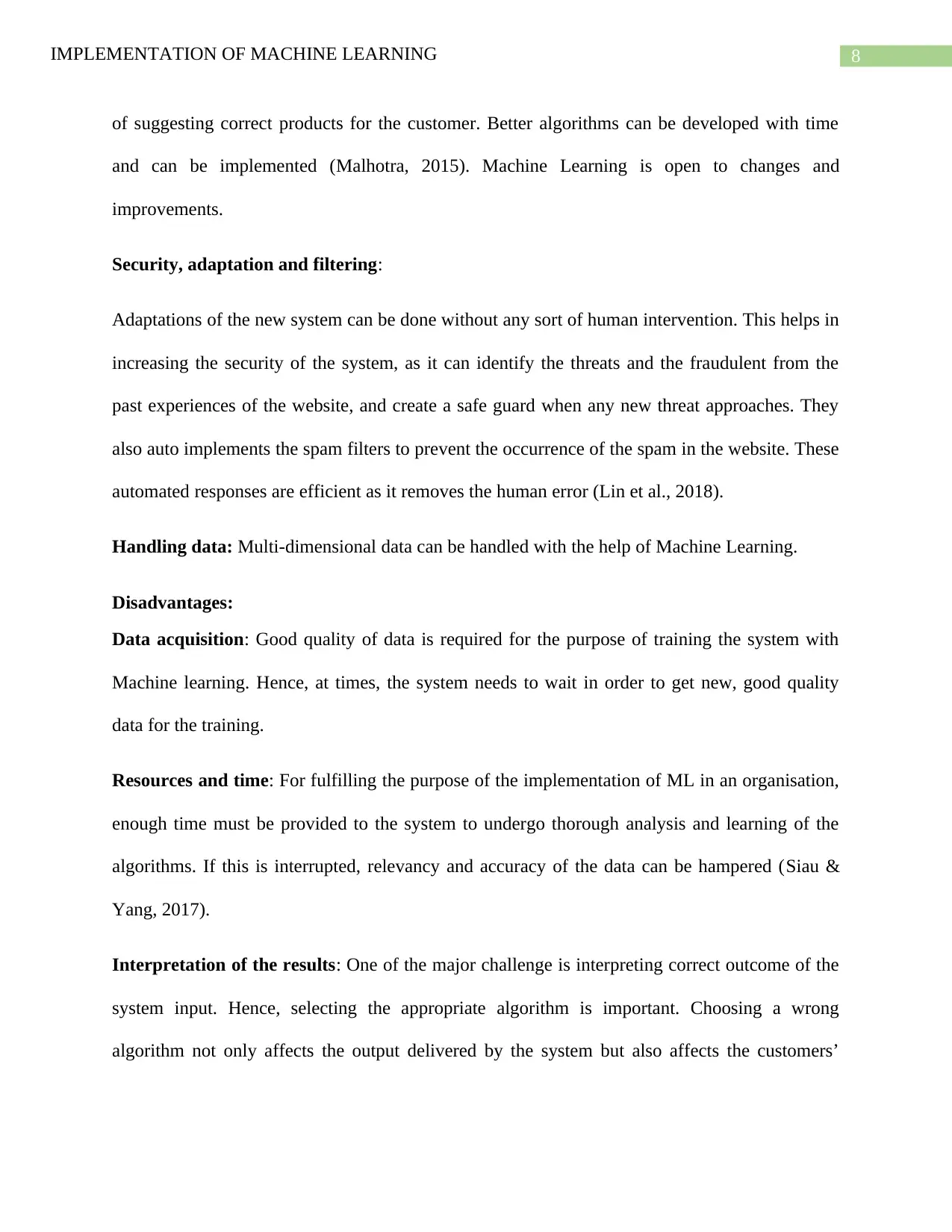
8IMPLEMENTATION OF MACHINE LEARNING
of suggesting correct products for the customer. Better algorithms can be developed with time
and can be implemented (Malhotra, 2015). Machine Learning is open to changes and
improvements.
Security, adaptation and filtering:
Adaptations of the new system can be done without any sort of human intervention. This helps in
increasing the security of the system, as it can identify the threats and the fraudulent from the
past experiences of the website, and create a safe guard when any new threat approaches. They
also auto implements the spam filters to prevent the occurrence of the spam in the website. These
automated responses are efficient as it removes the human error (Lin et al., 2018).
Handling data: Multi-dimensional data can be handled with the help of Machine Learning.
Disadvantages:
Data acquisition: Good quality of data is required for the purpose of training the system with
Machine learning. Hence, at times, the system needs to wait in order to get new, good quality
data for the training.
Resources and time: For fulfilling the purpose of the implementation of ML in an organisation,
enough time must be provided to the system to undergo thorough analysis and learning of the
algorithms. If this is interrupted, relevancy and accuracy of the data can be hampered (Siau &
Yang, 2017).
Interpretation of the results: One of the major challenge is interpreting correct outcome of the
system input. Hence, selecting the appropriate algorithm is important. Choosing a wrong
algorithm not only affects the output delivered by the system but also affects the customers’
of suggesting correct products for the customer. Better algorithms can be developed with time
and can be implemented (Malhotra, 2015). Machine Learning is open to changes and
improvements.
Security, adaptation and filtering:
Adaptations of the new system can be done without any sort of human intervention. This helps in
increasing the security of the system, as it can identify the threats and the fraudulent from the
past experiences of the website, and create a safe guard when any new threat approaches. They
also auto implements the spam filters to prevent the occurrence of the spam in the website. These
automated responses are efficient as it removes the human error (Lin et al., 2018).
Handling data: Multi-dimensional data can be handled with the help of Machine Learning.
Disadvantages:
Data acquisition: Good quality of data is required for the purpose of training the system with
Machine learning. Hence, at times, the system needs to wait in order to get new, good quality
data for the training.
Resources and time: For fulfilling the purpose of the implementation of ML in an organisation,
enough time must be provided to the system to undergo thorough analysis and learning of the
algorithms. If this is interrupted, relevancy and accuracy of the data can be hampered (Siau &
Yang, 2017).
Interpretation of the results: One of the major challenge is interpreting correct outcome of the
system input. Hence, selecting the appropriate algorithm is important. Choosing a wrong
algorithm not only affects the output delivered by the system but also affects the customers’
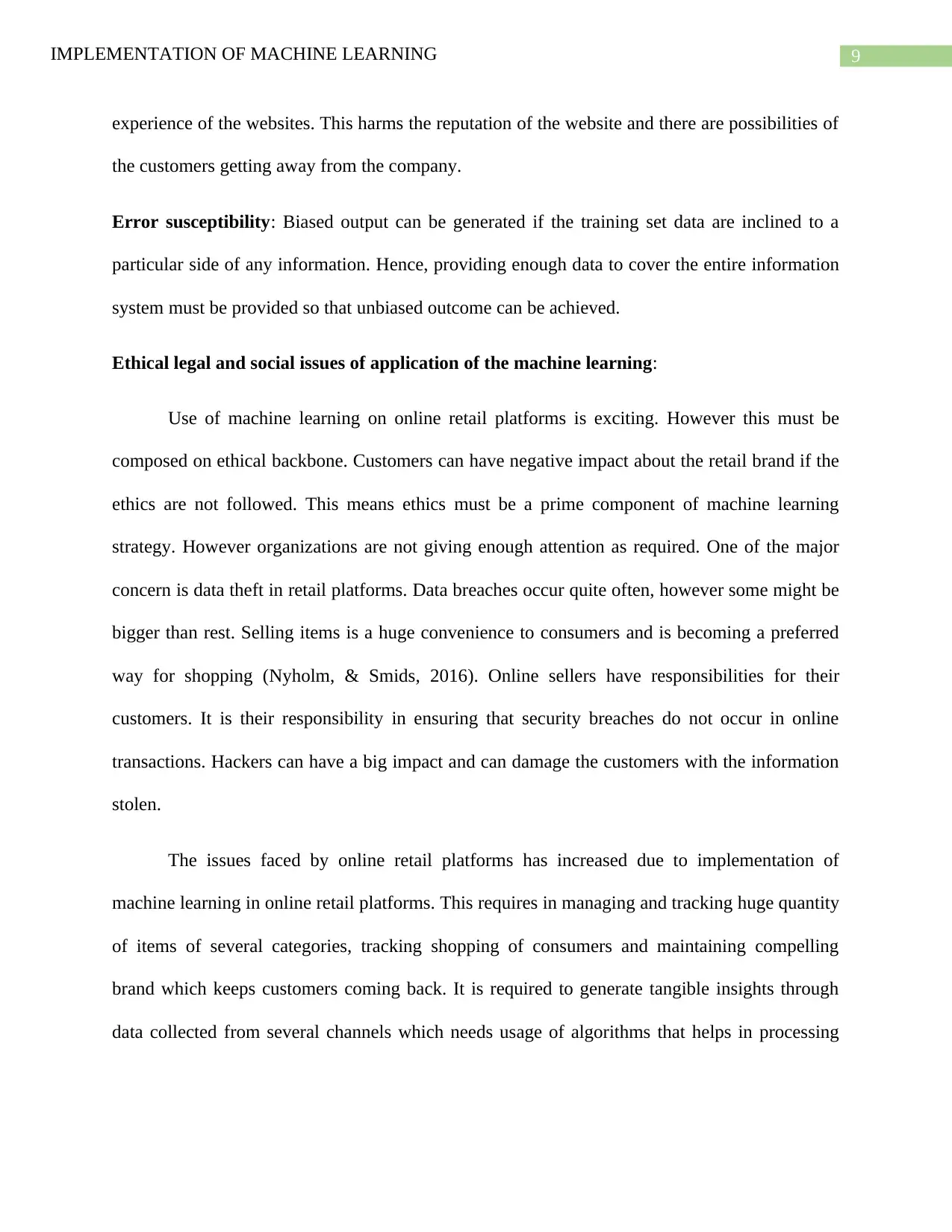
9IMPLEMENTATION OF MACHINE LEARNING
experience of the websites. This harms the reputation of the website and there are possibilities of
the customers getting away from the company.
Error susceptibility: Biased output can be generated if the training set data are inclined to a
particular side of any information. Hence, providing enough data to cover the entire information
system must be provided so that unbiased outcome can be achieved.
Ethical legal and social issues of application of the machine learning:
Use of machine learning on online retail platforms is exciting. However this must be
composed on ethical backbone. Customers can have negative impact about the retail brand if the
ethics are not followed. This means ethics must be a prime component of machine learning
strategy. However organizations are not giving enough attention as required. One of the major
concern is data theft in retail platforms. Data breaches occur quite often, however some might be
bigger than rest. Selling items is a huge convenience to consumers and is becoming a preferred
way for shopping (Nyholm, & Smids, 2016). Online sellers have responsibilities for their
customers. It is their responsibility in ensuring that security breaches do not occur in online
transactions. Hackers can have a big impact and can damage the customers with the information
stolen.
The issues faced by online retail platforms has increased due to implementation of
machine learning in online retail platforms. This requires in managing and tracking huge quantity
of items of several categories, tracking shopping of consumers and maintaining compelling
brand which keeps customers coming back. It is required to generate tangible insights through
data collected from several channels which needs usage of algorithms that helps in processing
experience of the websites. This harms the reputation of the website and there are possibilities of
the customers getting away from the company.
Error susceptibility: Biased output can be generated if the training set data are inclined to a
particular side of any information. Hence, providing enough data to cover the entire information
system must be provided so that unbiased outcome can be achieved.
Ethical legal and social issues of application of the machine learning:
Use of machine learning on online retail platforms is exciting. However this must be
composed on ethical backbone. Customers can have negative impact about the retail brand if the
ethics are not followed. This means ethics must be a prime component of machine learning
strategy. However organizations are not giving enough attention as required. One of the major
concern is data theft in retail platforms. Data breaches occur quite often, however some might be
bigger than rest. Selling items is a huge convenience to consumers and is becoming a preferred
way for shopping (Nyholm, & Smids, 2016). Online sellers have responsibilities for their
customers. It is their responsibility in ensuring that security breaches do not occur in online
transactions. Hackers can have a big impact and can damage the customers with the information
stolen.
The issues faced by online retail platforms has increased due to implementation of
machine learning in online retail platforms. This requires in managing and tracking huge quantity
of items of several categories, tracking shopping of consumers and maintaining compelling
brand which keeps customers coming back. It is required to generate tangible insights through
data collected from several channels which needs usage of algorithms that helps in processing
Secure Best Marks with AI Grader
Need help grading? Try our AI Grader for instant feedback on your assignments.
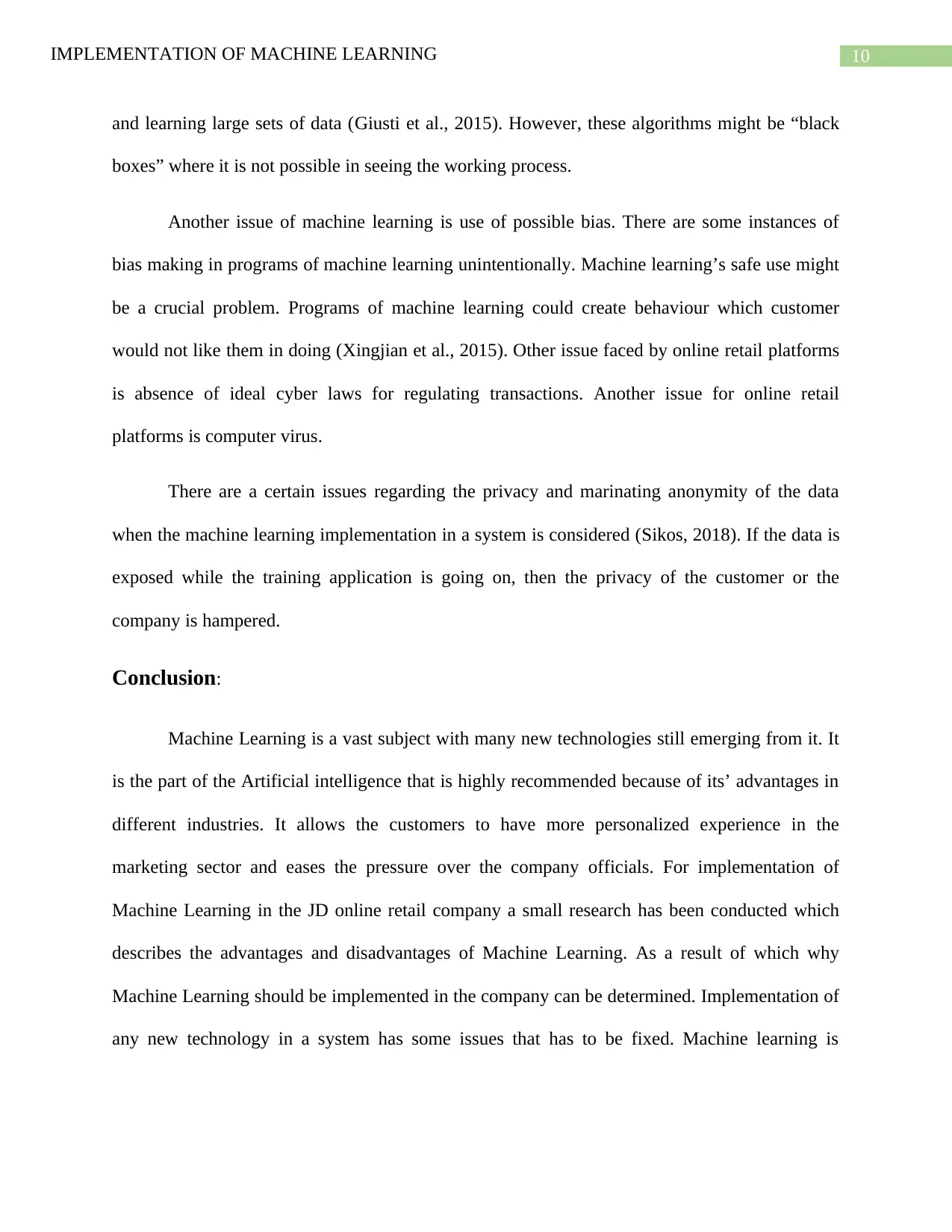
10IMPLEMENTATION OF MACHINE LEARNING
and learning large sets of data (Giusti et al., 2015). However, these algorithms might be “black
boxes” where it is not possible in seeing the working process.
Another issue of machine learning is use of possible bias. There are some instances of
bias making in programs of machine learning unintentionally. Machine learning’s safe use might
be a crucial problem. Programs of machine learning could create behaviour which customer
would not like them in doing (Xingjian et al., 2015). Other issue faced by online retail platforms
is absence of ideal cyber laws for regulating transactions. Another issue for online retail
platforms is computer virus.
There are a certain issues regarding the privacy and marinating anonymity of the data
when the machine learning implementation in a system is considered (Sikos, 2018). If the data is
exposed while the training application is going on, then the privacy of the customer or the
company is hampered.
Conclusion:
Machine Learning is a vast subject with many new technologies still emerging from it. It
is the part of the Artificial intelligence that is highly recommended because of its’ advantages in
different industries. It allows the customers to have more personalized experience in the
marketing sector and eases the pressure over the company officials. For implementation of
Machine Learning in the JD online retail company a small research has been conducted which
describes the advantages and disadvantages of Machine Learning. As a result of which why
Machine Learning should be implemented in the company can be determined. Implementation of
any new technology in a system has some issues that has to be fixed. Machine learning is
and learning large sets of data (Giusti et al., 2015). However, these algorithms might be “black
boxes” where it is not possible in seeing the working process.
Another issue of machine learning is use of possible bias. There are some instances of
bias making in programs of machine learning unintentionally. Machine learning’s safe use might
be a crucial problem. Programs of machine learning could create behaviour which customer
would not like them in doing (Xingjian et al., 2015). Other issue faced by online retail platforms
is absence of ideal cyber laws for regulating transactions. Another issue for online retail
platforms is computer virus.
There are a certain issues regarding the privacy and marinating anonymity of the data
when the machine learning implementation in a system is considered (Sikos, 2018). If the data is
exposed while the training application is going on, then the privacy of the customer or the
company is hampered.
Conclusion:
Machine Learning is a vast subject with many new technologies still emerging from it. It
is the part of the Artificial intelligence that is highly recommended because of its’ advantages in
different industries. It allows the customers to have more personalized experience in the
marketing sector and eases the pressure over the company officials. For implementation of
Machine Learning in the JD online retail company a small research has been conducted which
describes the advantages and disadvantages of Machine Learning. As a result of which why
Machine Learning should be implemented in the company can be determined. Implementation of
any new technology in a system has some issues that has to be fixed. Machine learning is
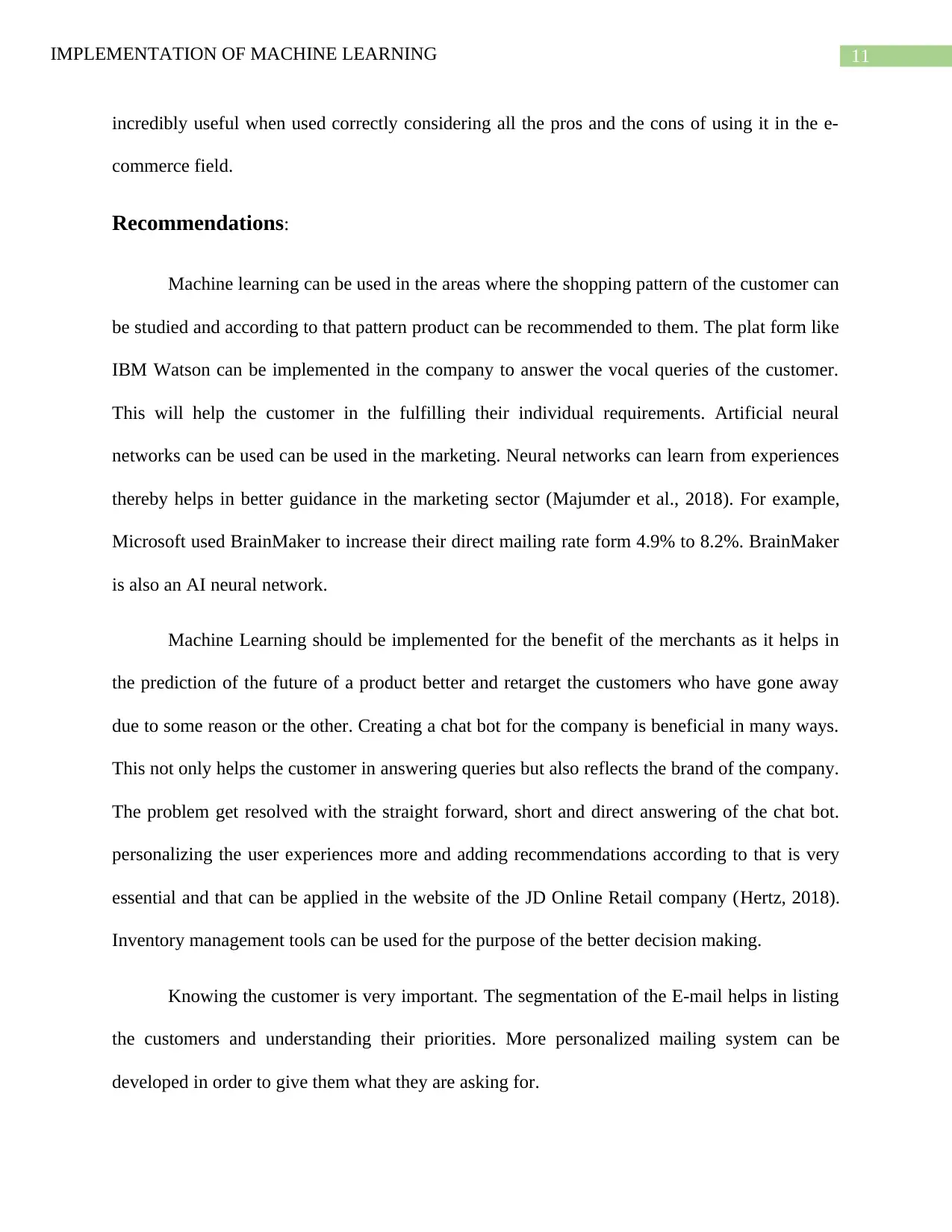
11IMPLEMENTATION OF MACHINE LEARNING
incredibly useful when used correctly considering all the pros and the cons of using it in the e-
commerce field.
Recommendations:
Machine learning can be used in the areas where the shopping pattern of the customer can
be studied and according to that pattern product can be recommended to them. The plat form like
IBM Watson can be implemented in the company to answer the vocal queries of the customer.
This will help the customer in the fulfilling their individual requirements. Artificial neural
networks can be used can be used in the marketing. Neural networks can learn from experiences
thereby helps in better guidance in the marketing sector (Majumder et al., 2018). For example,
Microsoft used BrainMaker to increase their direct mailing rate form 4.9% to 8.2%. BrainMaker
is also an AI neural network.
Machine Learning should be implemented for the benefit of the merchants as it helps in
the prediction of the future of a product better and retarget the customers who have gone away
due to some reason or the other. Creating a chat bot for the company is beneficial in many ways.
This not only helps the customer in answering queries but also reflects the brand of the company.
The problem get resolved with the straight forward, short and direct answering of the chat bot.
personalizing the user experiences more and adding recommendations according to that is very
essential and that can be applied in the website of the JD Online Retail company (Hertz, 2018).
Inventory management tools can be used for the purpose of the better decision making.
Knowing the customer is very important. The segmentation of the E-mail helps in listing
the customers and understanding their priorities. More personalized mailing system can be
developed in order to give them what they are asking for.
incredibly useful when used correctly considering all the pros and the cons of using it in the e-
commerce field.
Recommendations:
Machine learning can be used in the areas where the shopping pattern of the customer can
be studied and according to that pattern product can be recommended to them. The plat form like
IBM Watson can be implemented in the company to answer the vocal queries of the customer.
This will help the customer in the fulfilling their individual requirements. Artificial neural
networks can be used can be used in the marketing. Neural networks can learn from experiences
thereby helps in better guidance in the marketing sector (Majumder et al., 2018). For example,
Microsoft used BrainMaker to increase their direct mailing rate form 4.9% to 8.2%. BrainMaker
is also an AI neural network.
Machine Learning should be implemented for the benefit of the merchants as it helps in
the prediction of the future of a product better and retarget the customers who have gone away
due to some reason or the other. Creating a chat bot for the company is beneficial in many ways.
This not only helps the customer in answering queries but also reflects the brand of the company.
The problem get resolved with the straight forward, short and direct answering of the chat bot.
personalizing the user experiences more and adding recommendations according to that is very
essential and that can be applied in the website of the JD Online Retail company (Hertz, 2018).
Inventory management tools can be used for the purpose of the better decision making.
Knowing the customer is very important. The segmentation of the E-mail helps in listing
the customers and understanding their priorities. More personalized mailing system can be
developed in order to give them what they are asking for.

12IMPLEMENTATION OF MACHINE LEARNING
Paraphrase This Document
Need a fresh take? Get an instant paraphrase of this document with our AI Paraphraser
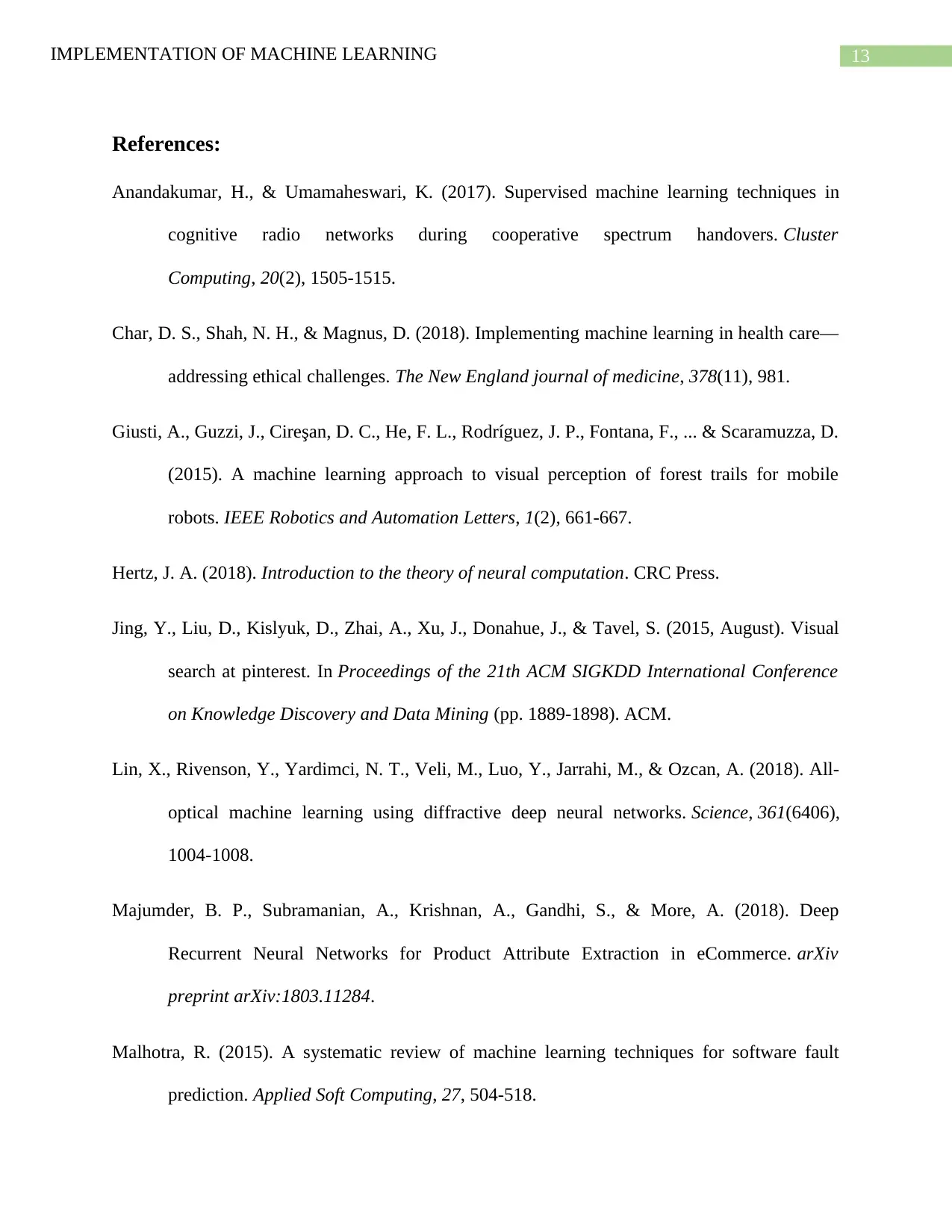
13IMPLEMENTATION OF MACHINE LEARNING
References:
Anandakumar, H., & Umamaheswari, K. (2017). Supervised machine learning techniques in
cognitive radio networks during cooperative spectrum handovers. Cluster
Computing, 20(2), 1505-1515.
Char, D. S., Shah, N. H., & Magnus, D. (2018). Implementing machine learning in health care—
addressing ethical challenges. The New England journal of medicine, 378(11), 981.
Giusti, A., Guzzi, J., Cireşan, D. C., He, F. L., Rodríguez, J. P., Fontana, F., ... & Scaramuzza, D.
(2015). A machine learning approach to visual perception of forest trails for mobile
robots. IEEE Robotics and Automation Letters, 1(2), 661-667.
Hertz, J. A. (2018). Introduction to the theory of neural computation. CRC Press.
Jing, Y., Liu, D., Kislyuk, D., Zhai, A., Xu, J., Donahue, J., & Tavel, S. (2015, August). Visual
search at pinterest. In Proceedings of the 21th ACM SIGKDD International Conference
on Knowledge Discovery and Data Mining (pp. 1889-1898). ACM.
Lin, X., Rivenson, Y., Yardimci, N. T., Veli, M., Luo, Y., Jarrahi, M., & Ozcan, A. (2018). All-
optical machine learning using diffractive deep neural networks. Science, 361(6406),
1004-1008.
Majumder, B. P., Subramanian, A., Krishnan, A., Gandhi, S., & More, A. (2018). Deep
Recurrent Neural Networks for Product Attribute Extraction in eCommerce. arXiv
preprint arXiv:1803.11284.
Malhotra, R. (2015). A systematic review of machine learning techniques for software fault
prediction. Applied Soft Computing, 27, 504-518.
References:
Anandakumar, H., & Umamaheswari, K. (2017). Supervised machine learning techniques in
cognitive radio networks during cooperative spectrum handovers. Cluster
Computing, 20(2), 1505-1515.
Char, D. S., Shah, N. H., & Magnus, D. (2018). Implementing machine learning in health care—
addressing ethical challenges. The New England journal of medicine, 378(11), 981.
Giusti, A., Guzzi, J., Cireşan, D. C., He, F. L., Rodríguez, J. P., Fontana, F., ... & Scaramuzza, D.
(2015). A machine learning approach to visual perception of forest trails for mobile
robots. IEEE Robotics and Automation Letters, 1(2), 661-667.
Hertz, J. A. (2018). Introduction to the theory of neural computation. CRC Press.
Jing, Y., Liu, D., Kislyuk, D., Zhai, A., Xu, J., Donahue, J., & Tavel, S. (2015, August). Visual
search at pinterest. In Proceedings of the 21th ACM SIGKDD International Conference
on Knowledge Discovery and Data Mining (pp. 1889-1898). ACM.
Lin, X., Rivenson, Y., Yardimci, N. T., Veli, M., Luo, Y., Jarrahi, M., & Ozcan, A. (2018). All-
optical machine learning using diffractive deep neural networks. Science, 361(6406),
1004-1008.
Majumder, B. P., Subramanian, A., Krishnan, A., Gandhi, S., & More, A. (2018). Deep
Recurrent Neural Networks for Product Attribute Extraction in eCommerce. arXiv
preprint arXiv:1803.11284.
Malhotra, R. (2015). A systematic review of machine learning techniques for software fault
prediction. Applied Soft Computing, 27, 504-518.
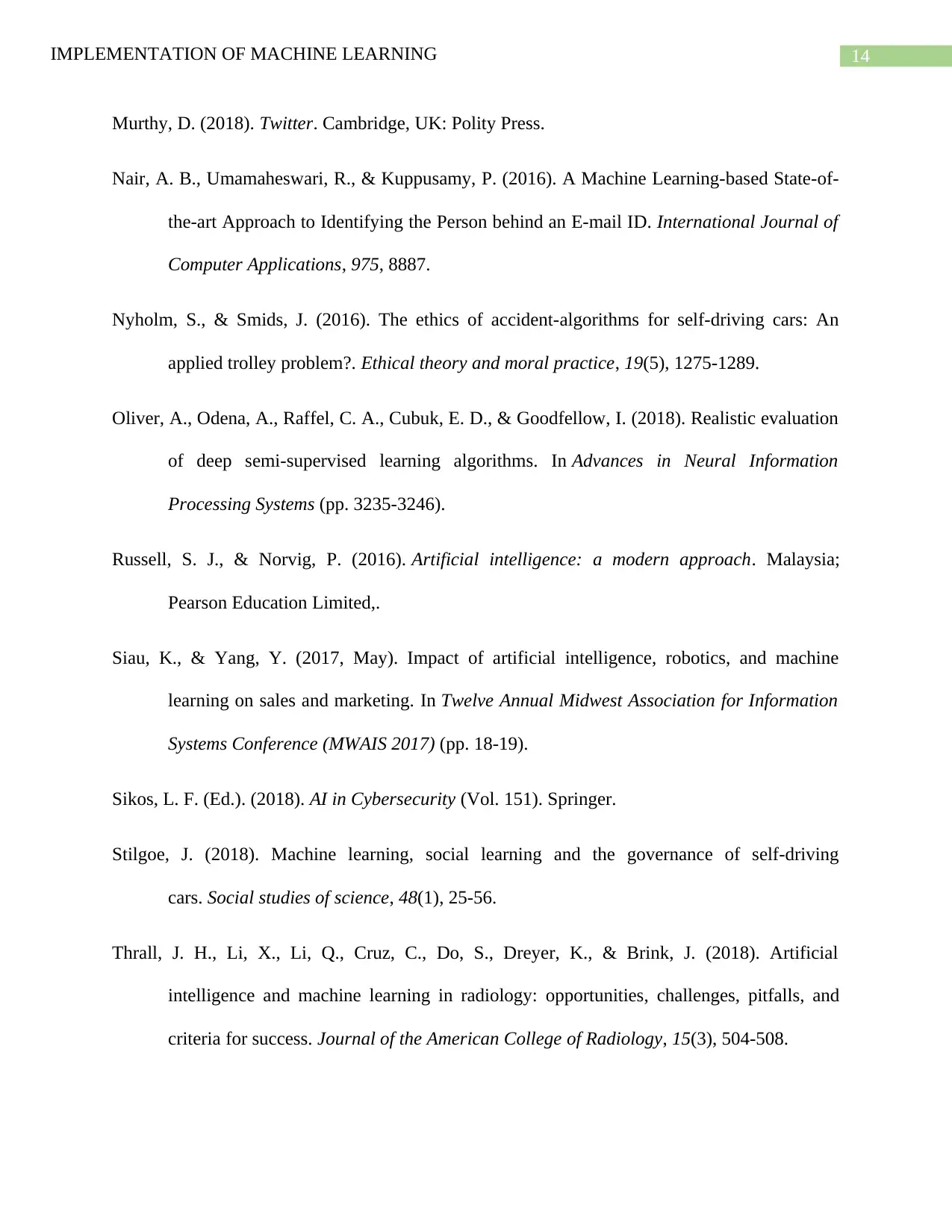
14IMPLEMENTATION OF MACHINE LEARNING
Murthy, D. (2018). Twitter. Cambridge, UK: Polity Press.
Nair, A. B., Umamaheswari, R., & Kuppusamy, P. (2016). A Machine Learning-based State-of-
the-art Approach to Identifying the Person behind an E-mail ID. International Journal of
Computer Applications, 975, 8887.
Nyholm, S., & Smids, J. (2016). The ethics of accident-algorithms for self-driving cars: An
applied trolley problem?. Ethical theory and moral practice, 19(5), 1275-1289.
Oliver, A., Odena, A., Raffel, C. A., Cubuk, E. D., & Goodfellow, I. (2018). Realistic evaluation
of deep semi-supervised learning algorithms. In Advances in Neural Information
Processing Systems (pp. 3235-3246).
Russell, S. J., & Norvig, P. (2016). Artificial intelligence: a modern approach. Malaysia;
Pearson Education Limited,.
Siau, K., & Yang, Y. (2017, May). Impact of artificial intelligence, robotics, and machine
learning on sales and marketing. In Twelve Annual Midwest Association for Information
Systems Conference (MWAIS 2017) (pp. 18-19).
Sikos, L. F. (Ed.). (2018). AI in Cybersecurity (Vol. 151). Springer.
Stilgoe, J. (2018). Machine learning, social learning and the governance of self-driving
cars. Social studies of science, 48(1), 25-56.
Thrall, J. H., Li, X., Li, Q., Cruz, C., Do, S., Dreyer, K., & Brink, J. (2018). Artificial
intelligence and machine learning in radiology: opportunities, challenges, pitfalls, and
criteria for success. Journal of the American College of Radiology, 15(3), 504-508.
Murthy, D. (2018). Twitter. Cambridge, UK: Polity Press.
Nair, A. B., Umamaheswari, R., & Kuppusamy, P. (2016). A Machine Learning-based State-of-
the-art Approach to Identifying the Person behind an E-mail ID. International Journal of
Computer Applications, 975, 8887.
Nyholm, S., & Smids, J. (2016). The ethics of accident-algorithms for self-driving cars: An
applied trolley problem?. Ethical theory and moral practice, 19(5), 1275-1289.
Oliver, A., Odena, A., Raffel, C. A., Cubuk, E. D., & Goodfellow, I. (2018). Realistic evaluation
of deep semi-supervised learning algorithms. In Advances in Neural Information
Processing Systems (pp. 3235-3246).
Russell, S. J., & Norvig, P. (2016). Artificial intelligence: a modern approach. Malaysia;
Pearson Education Limited,.
Siau, K., & Yang, Y. (2017, May). Impact of artificial intelligence, robotics, and machine
learning on sales and marketing. In Twelve Annual Midwest Association for Information
Systems Conference (MWAIS 2017) (pp. 18-19).
Sikos, L. F. (Ed.). (2018). AI in Cybersecurity (Vol. 151). Springer.
Stilgoe, J. (2018). Machine learning, social learning and the governance of self-driving
cars. Social studies of science, 48(1), 25-56.
Thrall, J. H., Li, X., Li, Q., Cruz, C., Do, S., Dreyer, K., & Brink, J. (2018). Artificial
intelligence and machine learning in radiology: opportunities, challenges, pitfalls, and
criteria for success. Journal of the American College of Radiology, 15(3), 504-508.
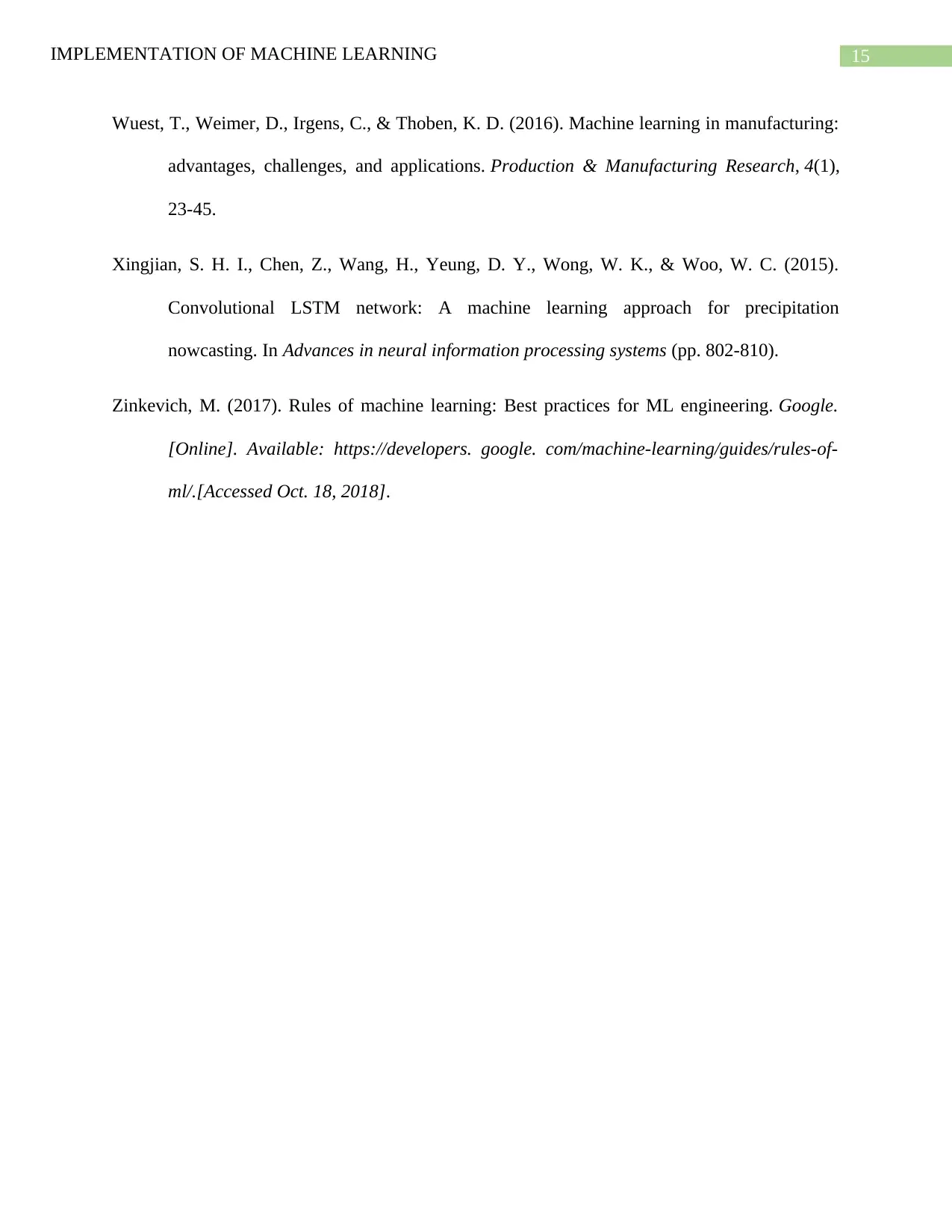
15IMPLEMENTATION OF MACHINE LEARNING
Wuest, T., Weimer, D., Irgens, C., & Thoben, K. D. (2016). Machine learning in manufacturing:
advantages, challenges, and applications. Production & Manufacturing Research, 4(1),
23-45.
Xingjian, S. H. I., Chen, Z., Wang, H., Yeung, D. Y., Wong, W. K., & Woo, W. C. (2015).
Convolutional LSTM network: A machine learning approach for precipitation
nowcasting. In Advances in neural information processing systems (pp. 802-810).
Zinkevich, M. (2017). Rules of machine learning: Best practices for ML engineering. Google.
[Online]. Available: https://developers. google. com/machine-learning/guides/rules-of-
ml/.[Accessed Oct. 18, 2018].
Wuest, T., Weimer, D., Irgens, C., & Thoben, K. D. (2016). Machine learning in manufacturing:
advantages, challenges, and applications. Production & Manufacturing Research, 4(1),
23-45.
Xingjian, S. H. I., Chen, Z., Wang, H., Yeung, D. Y., Wong, W. K., & Woo, W. C. (2015).
Convolutional LSTM network: A machine learning approach for precipitation
nowcasting. In Advances in neural information processing systems (pp. 802-810).
Zinkevich, M. (2017). Rules of machine learning: Best practices for ML engineering. Google.
[Online]. Available: https://developers. google. com/machine-learning/guides/rules-of-
ml/.[Accessed Oct. 18, 2018].
1 out of 16
Related Documents
Your All-in-One AI-Powered Toolkit for Academic Success.
+13062052269
info@desklib.com
Available 24*7 on WhatsApp / Email
![[object Object]](/_next/static/media/star-bottom.7253800d.svg)
Unlock your academic potential
© 2024 | Zucol Services PVT LTD | All rights reserved.





